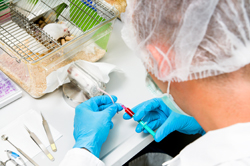Unravelling immune system disorders
Haemophagocytic lymphohistiocytosis (HLH) is a life-threatening disorder associated with uncontrolled inflammation. Genetic defects in Perforin (PRF1), UNC13D, Syntaxin 11 (STX11) and UNC18B are encountered in HLH patients and are associated with the impairment of lymphocyte cytotoxicity.However the difficulty in diagnosing HLH purely based on its clinical symptoms often delays treatment and may have serious consequences for the patient. This clearly indicates that novel molecular diagnostic tools are required for rapid diagnosis and should be combined with new, more effective therapies. To address these issues, the EU-funded CUREHLH project aimed to investigate the aetiology and pathophysiology of HLH following a multi-disciplinary approach that involved mouse models, in vitro human assays and patient samples. Details can be found at the project website(opens in new window). Pre-clinical work in experimental mouse models illustrated that HLH did not develop spontaneously but required the presence of an external trigger such as infection with Lymphocytic Choriomeningitis Virus (LCMV). LCMV infection generated chronically activated T cells, and mice were unable to eliminate the virus and developed HLH symptoms. Importantly, scientists discovered that virus persistence and clearance in the various mouse strains were of paramount importance for HLH development. Given that HLH is associated with defects in effector molecules, like perforin, and in genes that are involved in the transport and release of lytic granules, the consortium used animal models with different defects in the lytic process. Results showed that HLH is a threshold disease that causes cytotoxicity of T lymphocytes. Work to evaluate the role of cytokines in the HLH defect of immune cell cytotoxicity indicated that IL-15 was vital for the cytotoxicity of natural killer (NK) cells and cytotoxic T cells. Detailed characterisation of patients with different forms of HLH in terms of genetics, cytokine expression and NK cell function enabled researchers to perform meaningful genotype-to-phenotype associations. Also, it helped identify pathways that could be used as therapeutic targets for HLH, as in the case of IL-15 and its receptor. CUREHLH findings provided important insights into the function of the immune system — and especially that of NK cells and cytotoxic T lymphocytes — and the management of infectious diseases. The proposed tools and therapeutic interventions are expected to speed up diagnosis and improve disease outcome.







